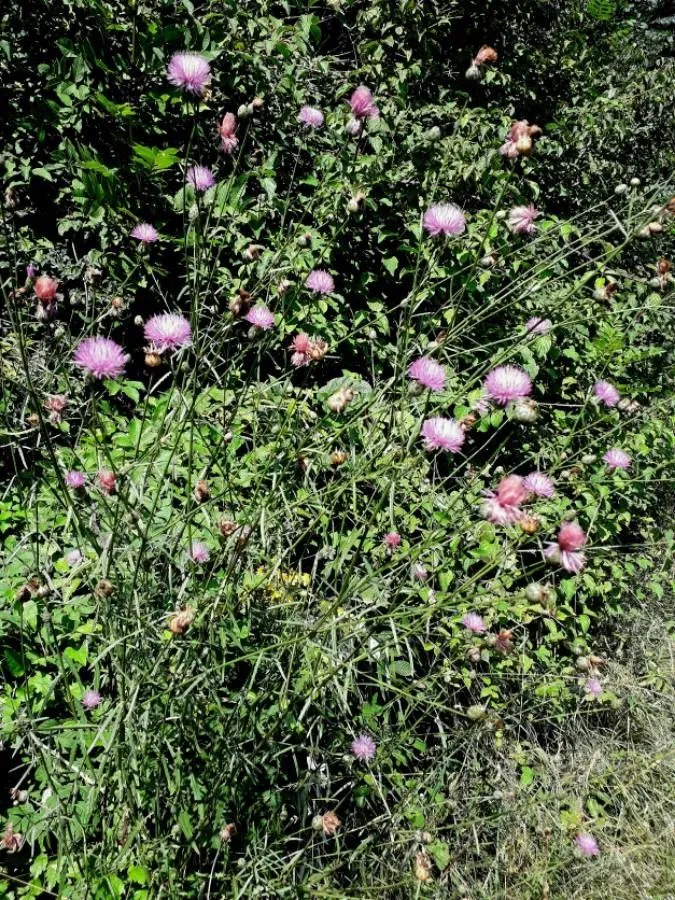
Author: L.
Bibliography: Sp. Pl.: 913 (1753)
Year: 1753
Status: accepted
Rank: species
Genus: Centaurea
Vegetable: False
Observations: Europe to Siberia and C. Asia
Greater centaury, scientifically named Centaurea scabiosa, is a remarkable species within the family Asteraceae. The vibrant and striking floral displays of this plant have made it a captivating sight across its widespread habitats.
First described by the renowned botanist Carl Linnaeus in his seminal work Species Plantarum in 1753, this perennial herb has secured its place in botanical history. With its origins rooted from Europe extending to Siberia and Central Asia, Greater centaury flourishes in a variety of terrains, particularly favoring grasslands, meadows, and roadside verges.
The plant is distinguished by its tall, robust stems and its large, intricate flower heads, which are typically a dazzling shade of purple. These composite flowers are composed of numerous florets, creating an attractive dome-like appearance. Its leaves are lanceolate and deeply lobed, presenting a delicate contrast to the bold flowers that bloom from mid-summer to early autumn.
Ecologically, Greater centaury plays a significant role in supporting wildlife, particularly pollinators such as bees and butterflies, who are drawn to its nectar-rich flowers. Despite its allure, it’s important to note that Centaurea scabiosa can become locally dominant under certain conditions, which necessitates mindful management to preserve biodiversity.
In addition to its ecological value, Greater centaury has been used traditionally in herbal medicine for its various attributed benefits. While scientific backing for these uses remains limited, the historical context highlights the plant’s role in various cultural and medicinal practices.
Overall, Greater centaury stands out not only for its botanical beauty but also for its contribution to ecological health and its rich historical presence in herbal lore, proving that its significance extends well beyond its aesthetic appeal.
Dan: almindelig ær, esparsette, liden fugleklo, mark-stenkløver, stor knopurt, strand-krageklo
Swe: busktörne, dvärgserradella, esparsett, gul sötväppling, väddklint, ärt
Nor: dvergserradella, ert, esparsett, lækjesteinkløver, tornbeinurt
Fin: esparsetti, herne, kääpiölinnunjalka, piikkiorakko, rohtomesikkä
Eng: greater centaury, greater knapweed, hardheads, scabious knapweed, great starthistle, greater centaurea, rough knapweed
Deu: skabiosen-flockenblume, skabiosenflockenblume, stachelige skabiosen-flockenblume
Fra: centaurée scabieuse
Nld: grote centaurie
Sme: giedderohkarássi
Cym: cramennog fwyaf, cramennog yr ŷd, gramedog fwyaf, llys y tarw, llysiau’r tarw, pengaled coch, pengaled fawr, pengaled fwyaf, pengaled mawr, y bengaled fawr
En: Greater centaury, Greater knapweed, Scabious knapweed, Hardheads, Great starthistle, Greater centaurea, Rough knapweed
Ar: قنطريون أجرب
Eu: Astuzker
Be: Васілёк шурпаты
Ca: Gratabous
Cs: Chrpa čekánek
Da: Stor Knopurt, Almindelig Ær, Esparsette, Liden Fugleklo, Mark-Stenkløver, Strand-Krageklo
Nl: Grote centaurie
Eo: Skabioza centaŭreo
Et: Põldjumikas
Fi: Ketokaunokki, Esparsetti, Herne, Kääpiölinnunjalka, Piikkiorakko, Rohtomesikkä
Fr: Centaurée scabieuse, Centauree scabieuse
De: Skabiosen-Flockenblume, Scabiosenflockenblume, Skabiosenflockenblume, Stachelige Skabiosen-Flockenblume
Ga: Mínscoth mhór
It: Fiordaliso vedovino
Lv: Lielā dzelzene
Lt: Didžiagalvė bajorė
Se: Giedderohkarássi
No: Dvergserradella, Ert, Esparsett, Lækjesteinkløver, Tornbeinurt
Pl: Chaber driakiewnik
Pt-br: Centáurea-tinhosa
Ru: Василёк шероховатый
Sk: Nevädza hlaváčovitá, Nevädzník hlaváčovitý
Es: Anapera, Arnaza, Asnaza, Cabezuela, Cardo garrapata, Centaura mayor, Centaurea mayor, Centáurea mayor, Hierba pedorrera, Napera, Pedo-de-burro
Sv: Väddklint, Busktörne, Dvärgserradella, Esparsett, Gul sötväppling, Ärt
Uk: Волошка скабіозовидна
Cy: Y bengaled fawr, Cramennog Fwyaf, Cramennog yr Ŷd, Gramedog Fwyaf, Llys y Tarw, Llysiau’r Tarw, Pengaled Coch, Pengaled Fawr, Pengaled Fwyaf, Pengaled Mawr
Taken Jul 13, 2018 by Fejul Xeto (cc-by-sa)
Taken Jun 24, 2019 by Manu Pacha (cc-by-sa)
Taken Jul 13, 2018 by Fejul Xeto (cc-by-sa)
Taken May 20, 2017 by francois tissot (cc-by-sa)
Taken Jun 6, 2021 by marçal (cc-by-sa)
Taken Aug 25, 2021 by Llandrich anna (cc-by-sa)
Taken Jun 14, 2019 by Stefan Kamps (cc-by-sa)
Taken Jul 8, 2019 by Manu Pacha (cc-by-sa)
Taken Jul 13, 2018 by Fejul Xeto (cc-by-sa)
Taken Jul 13, 2018 by Fejul Xeto (cc-by-sa)
Taken Jun 14, 2019 by Stefan Kamps (cc-by-sa)
Taken Jun 19, 2021 by Pierre LEON (cc-by-sa)
Taken Oct 14, 2021 by Jacques Zuber (cc-by-sa)
Taken Jun 30, 2020 by Llandrich anna (cc-by-sa)
Taken Jul 13, 2018 by Fejul Xeto (cc-by-sa)
Taken Jul 15, 2021 by Jani Zadrgal (cc-by-sa)
Taken Jun 2, 2022 by benemoth (cc-by-sa)
Taken Jun 21, 2020 by Sylvain Piry (cc-by-sa)
Taken Jul 11, 2021 by Manuëlle (cc-by-sa)
Taken Aug 28, 2021 by Manuëlle (cc-by-sa)
Taken Aug 23, 2022 by Stefan Spoon (cc-by-sa)
Taken May 26, 2017 by Yoan MARTIN (cc-by-sa)
Taken Jul 22, 2012 by Tela Botanica − Yoan MARTIN (cc-by-sa)
Taken Jul 8, 2019 by Manu Pacha (cc-by-sa)
Taken Jul 9, 2021 by Llandrich anna (cc-by-sa)
Taken Jul 27, 2018 by Dieter Wagner (cc-by-sa)
Taken Jul 27, 2018 by Dieter Wagner (cc-by-sa)
Taken Sep 19, 2022 by David Hocken (cc-by-sa)
Taken Jun 14, 2021 by Nala Potiron (cc-by-sa)
Taken Jun 11, 2021 by Albert Mallol Camprubí (cc-by-sa)
© copyright of the Board of Trustees of the Royal Botanic Gardens, Kew.
© copyright of the Board of Trustees of the Royal Botanic Gardens, Kew.
© copyright of the Board of Trustees of the Royal Botanic Gardens, Kew.
Growth habit: Forb/herb
Ph maximum: 8.0
Ph minimum: 7.5
Light: 7
Atmospheric humidity: 4
Bloom months: [‘jul’, ‘aug’]
Soil nutriments: 4
Family: Myrtaceae Author: (F.Muell.) K.D.Hill & L.A.S.Johnson Bibliography: Telopea 6: 402 (1995) Year: 1995 Status:…
Family: Rubiaceae Author: Pierre ex A.Froehner Bibliography: Notizbl. Bot. Gart. Berlin-Dahlem 1: 237 (1897) Year:…
Family: Sapindaceae Author: Koidz. Bibliography: J. Coll. Sci. Imp. Univ. Tokyo 32(1): 38 (1911) Year:…
Family: Asteraceae Author: A.Gray Bibliography: Pacif. Railr. Rep.: 107 (1857) Year: 1857 Status: accepted Rank:…
Family: Fabaceae Author: Medik. Bibliography: Vorles. Churpfälz. Phys.-Ökon. Ges. 2: 398 (1787) Year: 1787 Status:…
Family: Aspleniaceae Author: (Cav.) Alston Bibliography: Bull. Misc. Inform. Kew 1932: 309 (1932) Year: 1932…